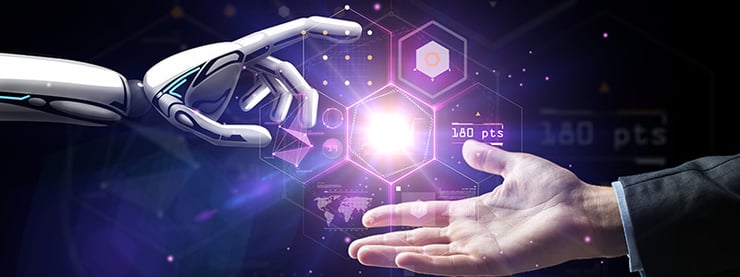According to Grand View Research, the global market for chatbots will reach $1.23 billion by 2025, which would be a compounded growth rate of 24.3%. Inventor and technologist Ray Kurzweil predicts that by 2029, chatbots will be indistinguishable from humans. And 80% of businesses say they’ll be using chatbots by the end of 2020.
What Are Chatbots?
Simply put, chatbots are computer programs that simulate human interaction based on a predefined set of conditions or triggers. While chatbots have been around since the 1960’s, they have only recently found their way into business applications. We most commonly think of chatbots for customer service or sales on websites, but they are also present on Facebook and provide the underlying technology for virtual assistants (e.g., Alexa, Siri, and Cortana).
It’s important to understand the differences between chatbots and virtual assistants. While the two technologies share common roots and fulfill similar purposes, they are certainly not the same. Unlike virtual assistants, chatbots are programmed to fill a very specific purpose and therefore have a slightly more limited scope of functionality.
While virtual assistants can handle a wider array of tasks and interactions, this ability to learn can actually make them less desirable in the enterprise because they must constantly be monitored. A chatbot is much less likely than a virtual assistant to “go rogue” based on what it has learned; it will always respond based on its programming, an advantageous attribute in the business world, where a misstep can result in anything from a lost customer to a serious PR issue.
Most chatbots operate on one of two models: selective and generative. Selective chatbots, sometimes also called retrieval chatbots, retrieve their responses from a predetermined list. These chatbots tend to be relatively limited in their capabilities since they can’t improvise, that is, make up new responses on their own.
Generative chatbots are considered “smarter” because they can create new responses using machine learning. They sort through many layers of information to synthesize the best response to a person’s request. While at first, responses may only come from the preset responses the chatbot is “taught,” over time generative chatbots add to their own repertoire.
A Brief History of Chatbots
The chatbot, or chatterbot as it was first called, made its debut in 1966 with ELIZA. Developed by Joseph Weizenbaum at Massachusetts Institute of Technology (MIT), ELIZA could mimic human conversation by responding to user prompts with scripted rejoinders. For example, if a human said, “My mother is a great cook,” Eliza might build from the word “mother” and respond with “Tell me more about your family.”
These open-ended responses helped create the illusion of human interaction; for a time, ELIZA passed the Turing test. ELIZA had diverse capabilities. Her DOCTOR program emulated the conversations of a psychologist conducting Rogerian therapy.
Perhaps that’s why the next chatbot, PARRY, imitated a patient with paranoid schizophrenia. Created by Stanford University professor Kenneth Colby in 1972, PARRY was trained throughout the early 1970s by a team of 33 psychologists. Eventually, PARRY could pass the Turing more than 50% of the time. ELIZA and PARRY had a historic meeting in September 1972. The encounter ended when PARRY called ELIZA a nag, and ELIZA requested $399.29 in payment. PARRY clearly outpaced ELIZA thanks to great strides in machine learning in the years since ELIZA’s invention.
Fast forward to 1988. That year Rollo Carpenter introduced Jabberwacky, which primarily offered entertainment. However, Carpenter’s ultimate goal was to build a chatbot that was entirely voice-operated, much like today’s virtual assistants Alexa and Siri are.
1995 saw the release of Alice, the first chatbot to use NLP, or natural language processing. This allowed Alice to conduct more natural feeling conversations with her human inquisitors. Alice was also revolutionary in that the developer, Richard Wallace, made the base code open-source. Anyone who wanted to could use AIML, artificial intelligence markup language, to develop their own chatbots powered by Alice’s underlying technology.
Jumping into the new millennium, 2001 saw the introduction of SmartChild on the AIM and MSN Messenger platforms. SmartChild was the first chatbot to be able to carry out full interactions with human users, retrieve data from outside sources, and conduct so-called “chit-chat” conversations.
From there, development stalled out for a time, waiting for machine learning and other AI-related tech to catch up with demand. However, once 2010 hit, the development has been astonishing.
- 2010 — Apple announces Siri, the first chatbot to use a natural language user interface exclusively.
- 2012 — WIth the release of Google Now, Google joined in the race to develop a fully generative AI-powered chatbot. Developed for mobile search, Google Now is what’s often called a “predictive search” tool, in that it is designed to serve up answers to questions the user hasn’t thought to ask yet.
- 2014 — This year saw the release of two new-comers to the mobile PA field, Microsoft’s Cortana and Amazon’s Alexa. Cortana lives inside the Windows ecosystem, so it is designed to retrieve data based on context such as dates and times, send emails or texts on a schedule, or even just chat with the computer user. Alexa is built into Amazon’s line of Echo smart home devices and there is a stand-alone app as well. Using a strictly voice-activated UI, users can ask Alexa to play music on a connected system, find a restaurant, or get directions and deliver them to the user’s smartphone.
Chatbots have come a long way in a relatively short time. From early experiments that used basic computer programming to respond to human voices from a set of pre-determined scripts, to early examples of AI-powered bots that could mimic a human conversation. All the way to today, where machine learning and AI technology has progressed to the point where chatbots can put a friendly voice on mundane tasks like data retrieval in enterprise settings.
These chatbots free up human employees to get back to the intuitive tasks they excel at by taking the rote ones off their plate. At the same time, the NLP abilities they possess will leave your customers with the sense that their needs are being met quickly and efficiently, with no sense of having just conversed with a computer program.
Want to learn more about DRUID AI and how we can help streamline your business processes? Schedule a demo with a member of our team.





